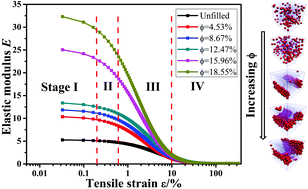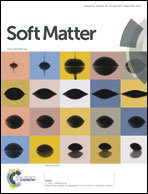Elucidating and tuning the strain-induced non-linear behavior of polymer nanocomposites: a detailed molecular dynamics simulation study†
Abstract
By setting up a coarse-grained model of polymer nanocomposites, we monitored the change in the elastic modulus as a function of the strain, derived from the stress–strain behavior by determining uniaxial tension and simple shear of two typical spatial distribution states (aggregation and dispersion) of nanoparticles (NPs). In both these cases, we observed that the elastic modulus decreases non-linearly with the increase of strain and reaches a low plateau at larger strains. This phenomenon is similar to the so-called “Payne effect” for elastomer nanocomposites. Particularly, the modulus of the aggregation case is more sensitive to the imposed strain. By examining the structural parameters, such as the number of neighboring NPs, coordination number of NPs, root-mean-squared average force exerted on the NPs, local strain, chain conformations (bridge, dangle, loop, interface bead and connection bead), and the total interaction energy of NP–polymer and NP–NP, we inferred that the underlying mechanism of the aggregation case is the disintegration of the NP network or clusters formed through direct contact; however, for the dispersion case, the non-linear behavior is attributed to the destruction of the NP network or clusters formed through the bridging of adsorbed polymer segments among the NPs. The former physical network is influenced by NP–NP interaction and NP volume fraction, while the latter is influenced by NP–polymer interaction and NP volume fraction. Lastly, we found that for the dispersion case, further increasing the inter-particle distance or grafting NPs with polymer chains can effectively reduce the non-linear behavior due to the decrease of the physical network density. In general, this simulation work, for the first time, establishes the correlation between the micro-structural evolution and the strain-induced non-linear behavior of polymer nanocomposites, and sheds some light on how to reduce the “Payne effect”.


 Please wait while we load your content...
Please wait while we load your content...